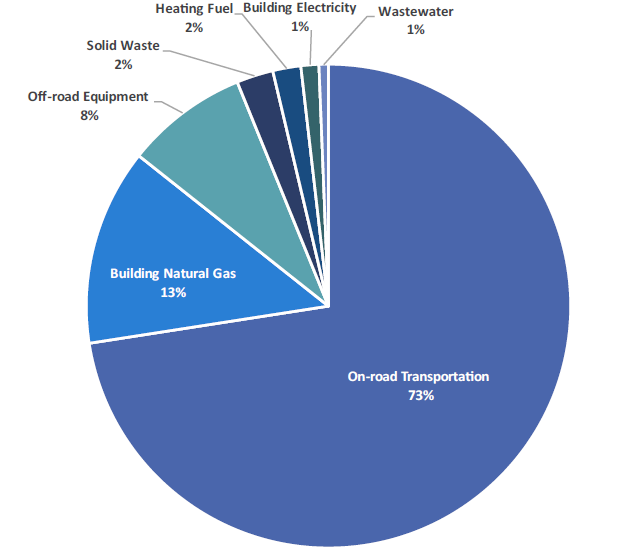The Collector
February 7, 2025
Latest Draft of Regional Climate Action Plan Published

The Humboldt County Regional Climate Action Plan is currently undergoing environmental review. According to county staff, the Draft Environmental Impact Report for the plan is expected to be released for public comment next month.
Meanwhile, the county recently uploaded a new draft of the plan to its website. It’s unusual for a plan to be updated in the middle of its environmental review. We’re still reviewing the changes, but we expect that they will be relatively minor and focused on comments submitted last fall.
We are keeping our eye on the big picture: almost three-quarters of the climate pollution covered by the plan comes from on-road transportation, mostly private cars and trucks. Transitioning to electric vehicles will be necessary but not sufficient to meet climate goals, and local governments have limited influence over private vehicle purchases. Which means there is no way the plan can achieve significant emissions reductions without major infrastructure, land use, and transit improvements to support more walking, biking and bus riding.
Federal Funding Uncertainty Hangs Over Local Plans
Some important local transportation planning efforts may be directly affected by the Trump administration’s ongoing efforts to freeze previously approved federal funding – including from two of the biggest transportation programs – and dismantle programs that don’t meet right-wing ideological purity tests. The Humboldt County Association of Governments (HCAOG) has received federal funding from at least two programs that appear to be targeted by Trump. One is a grant from the Safe Streets and Roads for All program to develop a regional Vision Zero plan to eliminate traffic fatalities and serious injuries. The other is an allocation from the Carbon Reduction Program, which local agencies intend to use to develop a plan for transitioning local fleets to zero-emission vehicles. Funds from both programs were awarded during the Biden administration, but the projects have not yet started.
Both of these federal funding programs are part of the Infrastructure Investment and Jobs Act (a.k.a. the Bipartisan Infrastructure Law), one of the programs specifically frozen by a Trump executive order. Furthermore, the new administration’s hostility toward climate action and electric vehicle infrastructure is well established, and even seemingly uncontroversial transportation safety programs are now being targeted by the administration. Given this political environment and the unprecedented attempts to interfere with federal funding that’s already been already allocated, local officials and advocates are extremely concerned that crucial safety, environmental and equity programs like those pursued by HCAOG will be de-funded or otherwise undermined.
Adding to the anxiety are concerns about what restrictions may be placed on future federal funding – especially with the new federal leadership making odd and unprecedented announcements about things like tying transportation funding amounts to local birth and marriage rates.
News from Beyond the North Coast
Right Turns on Red Are Dangerous
Right-turn-on-red laws were introduced during the oil crisis of the 1970s under the somewhat absurd premise that the US would save a significant amount fuel by allowing drivers to spend less time idling at intersections. A new study adds to years of evidence that drivers rarely come to a complete stop when making a right on red, and pedestrians and bicyclists are paying the price for this behavior.
Driving an Enormous Vehicles Won’t Make You Safer
It is well established that bigger and taller SUVs and pickup trucks are much more dangerous for people outside the vehicle, especially pedestrians and bicyclists. But Americans keep buying bigger and bigger vehicles anyway, in part because of concerns for their own safety in the escalating “arms race” on our streets. New research challenges the assumption that bigger is safer for vehicle occupants, finding that drivers and passengers in today’s enormous vehicles are no safer than they would be in a smaller car.
The Collector is CRTP’s weekly transportation news roundup, published every Friday. We focus on North Coast news, but we also include relevant state, national and international transportation news – plus other items that we just find kind of interesting! To submit items for consideration, email colin@transportationpriorities.org.
